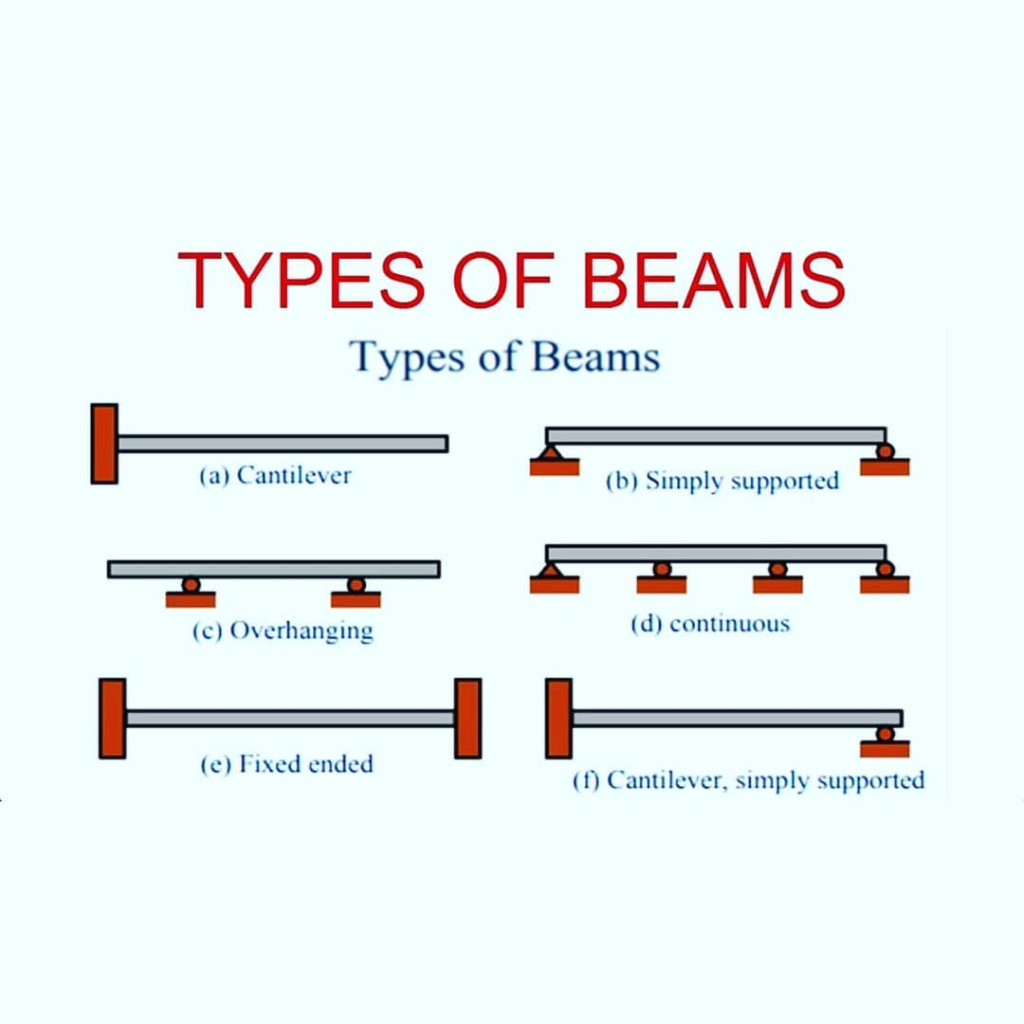A lot of times, while solving structural engineering problems, we found difficulty in understanding different types of beams.
This is very crucial to understand because different types of beams have different types of internal stresses and reactions to solve.
As explained here, the three common types of connections for a beam include roller, pinned, and fixed. The fourth type called simple support is not often found in real buildings and structures.
Now in this post, I’d like to start with the very basic definition of beam.
According to Britannica here, the beam is defined as :
A solid piece of timber, spanning an opening and carrying a load that may be a brick or stone wall above the opening.
In Civil Engineering terms we can define beam as:
A beam is a long slender member, a 2d element in structure having relatively longer span than the depth. In this post i will briefly explain different types of beams.
Beam is designed to carry the bending moment and the shear forces if any.
Like Us on Facebook!

Types of Beam Supports
Have you ever used some structural design software? There we use a term “restraint”. That is the same term used for the beam support. The beam support is its ability to withstand external forces in different ways. We provide these supports to resist vertical, horizontal, and movements.
Subscribe Us on YouTube!
Have you been through the structure analysis? There we use the term reactions. The reactions are the response of the beam when external loading is applied. That is because we design the structure to satisfy the conditions of equilibrium.
For information in depth refer to this article.
A simple example of a beam support is in your home. You can see a column at the end of the beam. Such a column gives you beam the fixed support. If you don’t know what is fixed support – carry on reading.
Here are the common types of beam supports:
- Roller support
- Fixed support
- Hinge support
Roller Support
Roller support mean you are giving beam the ability to resist vertical forces only. Such a beam is free to rotate and move along the surface on which it rests. In real life the roller support example can be a rubber bearing for a flyover.
Hinge Support
Hinge support is another type of beam support. It is also called pinned support. A beam with hinge support is capable of resisting forces acting in any direction of the plane. It provides resistance against horizontal and vertical forces only. However, it does not provide resistance against rotation. You can find out the support reactions for a hinge support by using two equations of equilibrium. The sum of all vertical forces is equal to zero and sum of all horizontal forces is equal to zero.
Fixed Support
A fixed support let the beam to resist vertical, horizontal forces as well as moment. Fixed support is also referred to as rigid support. It resists rotation as well as displacement. So, a simplest structure can take a fixed beam only to support itself.
The only difference between pinned and fixed support is in terms of rotation. Pinned support doesn’t resist moment or rotation while fixed support resist moment.
Based on the supports of the beam, Following are some of the classification of the beam.
Types of Beams based on supports
The following are the 6 different types of beams based on end supports or restraints:-
- Cantilever beam
- Simply Supported beam
- Overhanging beam
- Fixed beams
- Continuous beams
- Propped Cantilever beam
Cantilever Beam
A beam which is fixed at one end and free at the other end is known as cantilever beam, Or from statics point of view a beam with fixed support at one end resisting all the vertical, horizontal and bending moment produced as a result of loading of the beam and is free at the other end is cantilever beam. The beam is shown ;-

Simply Supported Beam
As the name suggests a beam which is supported or resting freely on supports at its both ends is known as simply supported beam. From mechanics point of view, a beam with both hinge support resisting horizontal and vertical forces and roller support fixing only one vertical force is known as a simply supported beam. Simply supported beam is also shown in the illustration below ;-

Such a beam can’t move horizontal or vertically but is free to rotate. It does not have any restraint avoiding rotation. It does not have any fixed support.
Practical life applications of simply supported beams with point loading include bridges, beams in buildings, and beds of machine tools.
Overhanging beam
If the end portion of the beam is extended beyond the support such a beam is known as overhanging beam.
In simple words you can say, an overhanging beam is a one that has simply supported beam when one portion overhangs the roller support.
Mostly in overhanging beam one support is Hinge support while other is roller support having one end as free like a cantilever. The shape of the beam is shown :-

Fixed Beam
A beam whose both ends are fixed or built-in walls, is known as fixed beam. A fixed beam is also known as built-in or encastred beam. A fixed beam usually have reinforcement that is going through the beam into the column as shown.

Continuous Beams
A beam which is provided more than two supports or is continuous over more than two supports is known as continuous beam. Usually in frame structure a continuous beam is used which have both positive and negatives moments you will be able to calculate later on.

Propped Cantilever Beam
A propped Cantilever beam is a little modification of the cantilever beam, if the free end of the cantilever beam is place on a roller support than the resultant beam will be propped cantilever beam as shown ;-























Thhat iis a good tip particularly to those new to the blogosphere.Simple but very accurate information… Appreciate your sharing this one.A must read post!
Thhat iis a good tip particularly to those new to the blogosphere.Simple but very accurate information… Appreciate your sharing this one.A must read post!
Thanks
Thanks